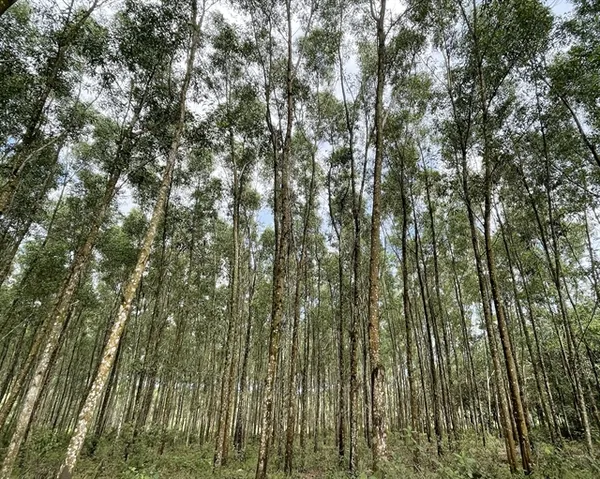| A corner of a planted managed forest in the central coastal province of Quảng Trị. VNA/VNS Photo Thanh Thủy |
QUẢNG TRỊ – Local people are happy and eager to benefit from forest protection and carbon credit sales in the central coastal province of Quảng Trị.
“Everyone feels happy when they receive the money,” Hồ Văn Chiến told the online newspaper Vietnamnet.
Chiến, 64, head of the Community Forest Management Board in Chênh Vênh village, Hướng Hóa district of the province, has participated in local forest patrols for the past eight years.
He said the board of directors, established in 2017, which was tasked with managing and protecting 600 hectares (ha) of natural forest, was composed entirely of ethnic Vân Kiều people.
In the beginning, everyone was a volunteer.
The board had six patrol teams, each consisting of six or seven members, and each team had three areas of forest to be checked every month along established routes.
Whenever they encountered strangers or signs of forest encroachment, the patrol teams intervened, repelled outsiders and reported any problems to authorities for appropriate action, he said.
Thanks to strict protection measures, the forest, with many large-diameter natural trees and valuable species previously listed in Vietnam’s Red Book of Critically Endangered Species, flourished and returned to the area.
“To be honest, we didn’t know anything about carbon credits before,” he said.
“We simply carried out the task of forest protection because we thought that protecting the forest meant protecting the habitat for future generations.”
In late 2023, Chiến learned about carbon credits and participated in several training courses.
In February, the village received its first carbon credit payment and distributed it to households.
Chiến said: “The money is not much, but it is still a motivation for the local people to better protect the forest.”
Because of their results, the village was asked to protect an additional 200 hectares of natural forest, bringing the total forest area under the village’s management to almost 800 hectares.
Hồ Văn Kiên, a member of the Forest Management and Protection Council in Ruộng Village, Hướng Hóa District, said the money from the sale of carbon credits was enough to make local people more determined to protect the forest.
The province is one of six provinces in the Central Region carrying out pilot projects in the field of carbon credit sales and financial management under the agreement to pay for the reduction of greenhouse gas emissions, according to Decree No. 107 /2022/NĐ-CP, issued by the government in 2022.
Last year, the province earned more than VNĐ51 billion ($1.99 million) from selling carbon credits, with the money going to forest protection teams in villages and forest owners.
On average, each hectare of natural forest receives approximately VNĐ120,000 ($4.7) from carbon absorption and storage services.
The province has more than 126,000 hectares of natural forest, of which more than 20,000 hectares are managed by forest protection teams.
Green certificates
In addition to protecting natural forests, the province can sell credits from planted forests.
The province currently has more than 26,000 hectares of trees that have been granted sustainable forest management certificates by the Forest Stewardship Council (FSC), the Việt Nam Forest Certification Scheme (VFCS) and the Program for the Endorsement of Forest Certification (PEFC).
Hoàng Đức Doanh, Chairman of the Quảng Trị Forest Certificate Holder Group, explained that the Forest Stewardship Council (FSC) is a non-governmental organization, founded in 1993, that issues guidelines for the development and management of sustainable forests worldwide.
FSC applies strict criteria and, if these are met, will issue an internationally recognized certificate.
Vietnam had its own standards, including 10 principles and 150 criteria based on FSC guidelines, he said.
In 2010, the province became the first place in Vietnam to receive the FSC Sustainable Forest Management certificate.
Doanh said he still remembers the initial difficulties in convincing locals at the time to plant certified forests because they were only familiar with traditional plantings.
The time needed to grow the new certified forests was significant; it took only four to five years to harvest traditionally planted timber, but took up to twelve years to harvest from a certified forest.
The business community was also hesitant at the time because there was no price differentiation on the market between certified and non-certified wood.
Hà Sỹ Đồng, vice chairman of the provincial People’s Committee, said that in 2008 the province invited international organizations to evaluate sustainable forest management at the Bến Hải Forestry Joint Stock Company.
They provided a 300-page document outlining the conditions that needed to be improved to achieve FSC certification, he said.
The process of overcoming these challenges took two years, as the World Wildlife Fund (WWF) and the Forest Stewardship Council re-evaluated the situation.
In 2010 the result was that approximately 95 percent of the recommendations had been followed.
Subsequently, Bến Hải Forestry One Member Co., Ltd became the first in Vietnam to receive the FSC Sustainable Forest Management certificate, he said.
Based on this model, certified forest plantings were expanded to many other places and from an initial 8,600 hectares of protected forest at the start of the program, there is now more than 26,000 hectares.
According to Doanh, local people can now see the benefits of planting certified forests.
Certified planted wood can be sold at higher prices, up to 12 percent more than regular wood, and companies can often sign large contracts.
In recent years, markets such as the US, EU and Japan have increased requirements for sustainable products, imposing new regulations on imported goods to stop illegal logging and prevent deforestation.
When timber was exported from certified forests, it therefore met the conditions to enter all markets, he said. If there were stable markets for timber exports, farmers’ livelihoods would also be stabilized. — VNS


